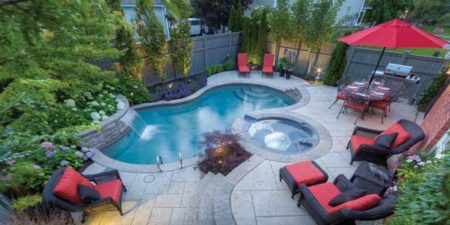A guide to installing a pond
By Chris Dahl
Sparkling water cascading over a waterfall, the vibrant colours or subtle fragrance of flowering water lilies and the graceful movements of curious koi and goldfish—these are just some of the wonderful features that make ponds so alluring. These water features can be the centrepiece of your backyard, transforming it into a beautiful oasis, full of life, where you can unwind and let the stresses of the day float away.
Design tips for your pond
Ponds can take many shapes or forms, including water gardens, formal water features or koi ponds. While there is no definitive right or wrong way to design a pond, there are some important design parameters you should consider to get the most enjoyment from them. Location, size, depth and filtration are just some of the aspects you should take into account before construction begins in order to achieve a healthy, low-maintenance ecosystem.
Location
When considering where to situate your pond, it is best to place it where you will enjoy it most. For example, if you spend a lot of time on your deck or patio, keep the pond close to or right beside the deck. What better way is there to enjoy your pond than to smell the fragrant flowers or feed the fish right from your favourite chair? Ideally, the pond should receive four to six hours of sunlight per day, since most aquatic plants require this much sunlight to stay healthy and produce plenty of flowers. It is also beneficial to keep the pond away from large trees, to prevent leaves and debris from falling in the pond.
Size
Although a pond can be designed to fit even the smallest backyard, try to build it as large as you possibly can. Most people get so much enjoyment from their pond, they soon ‘outgrow’ it. If you are unsure what size you want, talk to someone who already has a pond. They will likely tell you they wish they had built a much bigger pond (if they haven’t already upgraded to a larger version).
Depth
Even more important than size is depth. Not only do deeper ponds provide more room for fish to grow and exercise, they are actually easier to maintain. The added depth creates a more stable environment, where parameters such as temperature and water quality fluctuate much less. Shallow ponds tend to become warm and stagnant in the summer, which encourages algae growth, poor water quality and reduced clarity.
If you are planning a water garden to primarily grow plants with no or few fish, build it a minimum of 0.6-m (2-ft) deep. Koi ponds must be deeper to accommodate the needs of larger fish and should be a minimum 1.2-m (4-ft) deep. Also, don’t forget to incorporate some shelves, ranging from 304- to 609-mm (12- to 24-in.) deep, to accommodate marginal plants and water lilies.












